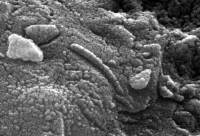| This high-resolution scanning electron microscope image shows an unusual tube-like
structural form that is less than 1/100th the width of a human hair in size found in meteorite
ALH84001, a meteorite believed to be of Martian origin. Although this structure is not part of
the research published in the Aug. 16 issue of the journal Science, it is located in a similar
carbonate glob in the meteorite. This structure will be the subject of future investigations that
could confirm whether or not it is fossil evidence of primitive life on Mars 3.6 billion years
ago (text and photo courtesy NASA). |  |
|


 Share This Page
Share This Page

 Share This Page
Share This Page

 Share This Page
Share This Page